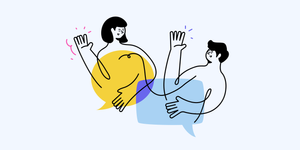Collaborative design is a fantastic facilitation tool that harnesses the collective input of stakeholders with diverse perspectives to generate the best ideas. While the specific methods may vary across industries, the ultimate goal remains consistent. By incorporating a variety of perspectives in a structured and intentional manner, we can do great things by inviting diverse perspectives into the work.
What I love about UX and collaborative design is that they are really a set of tools that allow you to problem-solve in different contexts. Once you learn the methodologies, you can apply them to anything. I’ve seen it work so many times, and it feels like magic each time because it's so effective and relatively fast. As a designer, this is a huge win.
This article will explore collaborative design in three different environments.
Example #1: Urban planning in Indonesia
In this example, Firm Foundation (a company that aims to reduce environmental vulnerability in riverfront settlements) worked with Solo Kota Kita (an Indonesian NGO that helps citizens and government officials understand the complexities of the built environment). Together, they organized workshops with three riverfront communities in Banjarmasin, Indonesia, to envision, design, and create a sustainable community space at the confluence of the Martapura River and Andai Canal. The city's planning and public works departments and local leaders were also invited to participate.

During the collaborative (or “participatory”) design process, residents got to vocalize ideas for improving their neighborhoods. Firm Foundation used different tools and activities to elicit the best information and feedback from the group, including:
- Transect walk: Observing and documenting the neighborhood with residents using a simple map and symbols.
- Neighborhood model: Building physical models to help residents understand relationships between different areas and scales.
- Problem tree: Visualizing and analyzing problems, causes, and effects to identify root issues and potential solutions.

This structured process allowed urban design solutions to unfold naturally, with much of the guesswork removed. The designers and planners still had the important job of executing the actual design, but they could draw on the valuable information and shared vision produced by the group.
Example #2: Community building in Detroit
The Detroit Collaborative Design Center (DCDC) uses a process called “Neighborhood Engagement Workshop” (NEW) to empower residents to renew their communities through collaboration and coalition-building.
“Workshops bring a mix of stakeholders, including community residents, youth, business owners, local government representatives, etc., to the same table to discuss neighborhood assets and needs. These diverse stakeholders often bring separate goals to the table, but through the workshop process, they achieve a common strategic vision that positively impacts each individual goal.”

This example stands out because of its focus on community-building. We start to see a common theme core to collaborative design, no matter the industry or specific process: bringing people with different perspectives together around a shared vision.
Typically, 20-30 people attend each DCDC workshop, with each participant asked to gather input from the larger community. The process also includes broader engagement strategies like surveys, comment boxes, and public events to gain input and feedback on the design.
Example #3: Architecture and integrated project delivery
In architecture, methods like Equal Design Partners (EDP) and Integrated Project Delivery (IDP) aim to involve all key stakeholders early in the design and decision-making process. Like a good software design and development process, IDP recognizes the value of understanding technical implications from the start. You can't design something optimally without that perspective.
One article notes, “Architects didn’t become architects to be designers among designers. They became architects to design.” This statement reflects the common perception that architecture is an individual pursuit, with the architect as the sole visionary. But in reality, the most successful architects recognize the value of collaboration.

Like UX/UI designers who work together to create better solutions, architects can enhance their creative vision by collaborating with others. The results can be incredibly powerful when a group of architects comes together to build on each other's best ideas. The collective expertise and diverse perspectives can lead to innovative designs that no single architect could have conceived alone.
Of course, this doesn’t mean architects should abandon their design sensibilities. Rather, it's about finding the right balance between personal vision and collaborative input. By being open to the ideas of others while still maintaining their unique point of view, architects can create designs that are distinctive and optimized for real-world needs.
Collaboration doesn’t mean compromising your design sensibilities. It’s about striking a balance between your vision and the valuable input of others. By being open to new ideas while staying true to your unique perspective, you can create distinctive and optimized designs for real-world needs. Collaboration allows you to tap into the collective wisdom and expertise of the group, arriving at solutions you might not have considered on your own.
However, it’s important to understand that collaborative design is not entirely about handing over the reins. It’s about facilitating a process that allows different viewpoints to enrich and refine the design. As the architect, you still critically synthesize these perspectives into a cohesive, functional end product, whether it's a building, a community space, or a landscape. Collaboration is a tool to enhance your design, not a replacement for your skill and vision.
The magic of collaborative design
Collaborative design is a potent tool for tackling complex challenges across industries. By bringing diverse stakeholders together in a structured process, we can uncover the best ideas, foster buy-in, and develop superior solutions more efficiently. This approach harnesses the collective intelligence and creativity of the group, leading to outcomes that are more than the sum of their parts.
I've witnessed the magic of collaborative design firsthand in my UX work, and the examples we've explored demonstrate its transformative potential in fields like urban planning, community-building, and architecture. Despite differences in specific activities, the core principles of inclusion, shared vision, and facilitated co-creation remain consistent. These principles create a framework for collaboration that anyone can adapt to suit the unique needs of any project or team.
We'll see collaborative design embraced more widely, from product development to policymaking. As our world becomes increasingly complex and interconnected, this approach offers a way to navigate that complexity and create solutions that truly work for everyone. While it may require a shift in mindset for those accustomed to working independently, the benefits of collaboration far outweigh any initial discomfort. Collaborative design unlocks innovation, builds consensus, and produces more robust and resilient outcomes.
If you haven’t tried collaborative design yet, I highly recommend it. Bring together a diverse group, create a space for open discussion, and watch as new ideas and possibilities emerge. No matter what you're working on - a digital product, a community project, or a building - you'll be amazed by the energy, creativity, and progress of designing together. So go for it - embrace collaborative design and see where it leads you.





